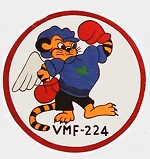Legion LEG14619LB USMC Chance-Vought F4U-1D Corsair Fighter - 1st Lt. Phillip DeLong, VMF-224 "Fighting Bengals", 1945 (1:72 Scale)
"Why should we have a navy at all? There are no enemies for it to fight except apparently the Army Air Force."
- General Carl Spaatz, Commander of the US 8th Army Air Force, after WWII
 The Vought F4U Corsair is an American fighter aircraft which saw service primarily in World War II and the Korean War. Designed and initially manufactured by Chance Vought, the Corsair was soon in great demand; additional production contracts were given to Goodyear, whose Corsairs were designated FG, and Brewster, designated F3A.
The Vought F4U Corsair is an American fighter aircraft which saw service primarily in World War II and the Korean War. Designed and initially manufactured by Chance Vought, the Corsair was soon in great demand; additional production contracts were given to Goodyear, whose Corsairs were designated FG, and Brewster, designated F3A.
The Corsair was designed and operated as a carrier-based aircraft, and entered service in large numbers with the U.S. Navy in late 1944 and early 1945. It quickly became one of the most capable carrier-based fighter-bombers of World War II. Some Japanese pilots regarded it as the most formidable American fighter of World War II and its naval aviators achieved an 11:1 kill ratio. Early problems with carrier landings and logistics led to it being eclipsed as the dominant carrier-based fighter by the Grumman F6F Hellcat, powered by the same Double Wasp engine first flown on the Corsair's initial prototype in 1940. Instead, the Corsair's early deployment was to land-based squadrons of the U.S. Marine Corps and U.S. Navy.
The Corsair served almost exclusively as a fighter-bomber throughout the Korean War and during the French colonial wars in Indochina and Algeria. In addition to its use by the U.S. and British, the Corsair was also used by the Royal New Zealand Air Force, French Naval Aviation, and other air forces until the 1960s.
From the first prototype delivery to the U.S. Navy in 1940, to final delivery in 1953 to the French, 12,571 F4U Corsairs were manufactured in 16 separate models. Its 1942-1953 production run was the longest of any U.S. piston-engined fighter.
Pictured here is a 1:72 scale replica of a US Navy Chance-Vought F4U-1D Corsair fighter that was piloted by 1st Lt. Phillip DeLong, who was attached to VMF-224 "Fighting Bengals" during 1945.
Now in stock!
Dimensions:
Wingspan: 7-inches
Length: 6-inches
Release Date: March 2023
 Historical Account: "Fighting Bengals" - Phillip C. DeLong was born on July 9th, 1919, in Jackson, Michigan. DeLong joined the Marine Corps on March 26, 1942. In December, he was commissioned as a second lieutenant and earned his flying wings. By August of 1943, DeLong was assigned to Marine Fighting Squadron 212 (VMF-212) in the Solomon Islands. By late-October, VMF-212 was based at Barakoma Airfield. About one month later, the squadron moved to Torokina Airfield.
Historical Account: "Fighting Bengals" - Phillip C. DeLong was born on July 9th, 1919, in Jackson, Michigan. DeLong joined the Marine Corps on March 26, 1942. In December, he was commissioned as a second lieutenant and earned his flying wings. By August of 1943, DeLong was assigned to Marine Fighting Squadron 212 (VMF-212) in the Solomon Islands. By late-October, VMF-212 was based at Barakoma Airfield. About one month later, the squadron moved to Torokina Airfield.
In the Solomon Islands, First Lieutenant DeLong flew the F4U Corsair and participated in bomber escort missions at Rabaul and Bougainville, where he shot down enemy planes which were attempting to down friendly bombers. These missions inflicted a great amount of damage on Japanese held airfields, shorelines, and ships. He also volunteered for strafing missions against heavily defended Japanese positions.
On February 15th, 1944, Lieutenant DeLong was on an aerial patrol providing overwatch for friendly troops landing on Green Island. When Japanese bombers were located approaching friendly ships, DeLong unhesitatingly flew through American anti-aircraft fire to engage the enemy planes. DeLong personally shot down three enemy planes and helped prevent the bombers from inflicting damage on our ships.
By mid-February, Lieutenant DeLong had downed eight Japanese planes and established himself as a flying ace. He also claimed to have probably downed a ninth enemy plane and he damaged two others. DeLong continued flying combat missions over the Bismarck Archipelago until April. DeLong was credited with downing a total of 11⅔ enemy aircraft during the war. He was awarded a total of four Distinguished Flying Crosses.





![USN Curtiss SB2C-1 Helldiver Dive-Bomber - VB-17, USS Bunker Hill (CV-17), Raid on Rabaul, Nov. 11th, 1943 [Closed Dive Brakes] (1:72 Scale)](http://cdn4.volusion.store/qh9e9-jdqv9/v/vspfiles/photos/HA2201-1.jpg?v-cache=1740197136)

![Imperial Japanese Army Nakajima Ki-27 Type 97 "Nate" Fighter - Lt. Col. Toshio Kato, 1st Sentai, Nomonhan, Mongolia, 1939 [With Collector Magazine] (1:72 Scale)](http://cdn4.volusion.store/qh9e9-jdqv9/v/vspfiles/photos/DAWF26-1.jpg?v-cache=1740197136)
